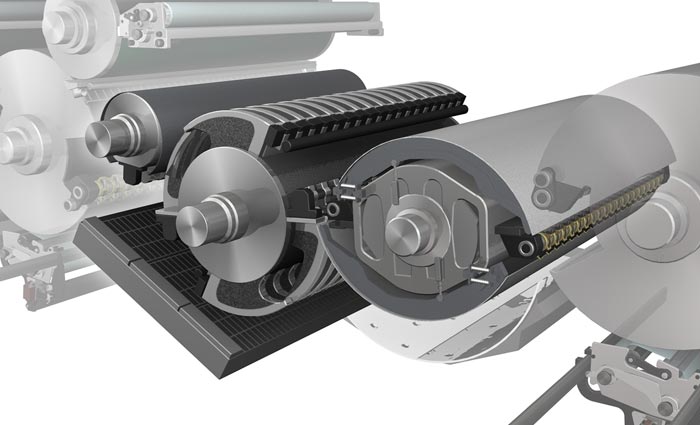
The XL105-P has a new delivery, perfecting device (pictured) and sheet guide to cope with the speed hike.
The world’s first machine has already been installed and tested in the UK. Lindsay Barnes, Heidelberg Australia’s general manager, Product Management, explained that while there were no local installs of the 18,000sph model, Australia was home to four XL 105 long perfectors, including the high-spec machine installed at McPhersons Printing last March.
The new XL 105 press will be among the products on show as part of Heidelberg’s Drupa exhibit next year.
Visitors to Heidelberg’s stand will walk through an ‘innovation gallery’ showing a glimpse of potential future developments, although the main focus on the stand proper will be on products that are real and working.
Marcel Kiessling, Heidelberg board member for services, said: “The best technology without the availability of that technology is worthless. Our focus is on making products that are available 24/7 for stable and sustainable production.”
It has revealed that the Cerm MIS system, acquired by Heidelberg in March, is being incorporated into its Prinect workflow to create a fully integrated platform for commercial and packaging printers. Heidelberg will also include source code from Pageflex into Prinect for web-to-print applications.
The German manufacturer has also augmented its Saphira range of consumables with a new Saphira Eco line designed to meet the toughest environmental requirements possible.
“We took the toughest environmental standards worldwide, and made sure our Saphira Eco range met them. This is the difference, we looked on a global basis at all known certificates,” said Kiessling.
To accompany the move, Heidelberg has created a new quality seal that can be used by customers that have switched over completely to Saphira Eco, to signify their environmental credentials.
Stephan Plenz, Heidelberg’s board member responsible for equipment, said: “It will definitely be a green Drupa from our point-of-view. Eco issues such as waste, CO2 and emissions reduction will be at the centre of what we do.”
Heidelberg has now calculated the carbon footprint involved in manufacturing all its presses, and is offering customers the option of buying a new press in a ‘carbon neutral’ state for an additional fee. The charge will depend on the press configuration, but Plenz gave a ballpark figure of €5,000 ($6,194).
“Customers can buy a carbon neutral press, so those customers who are interested in this can start from a clean point. All our presses and assets at Drupa will be carbon neutral.”
Plenz also hailed the market success of the 16,500sph Speedmaster CX 102, first shown at Ipex 2010. Heidelberg expected to deliver its 1,000th unit by the end of 2011. “Lots of print shops want the technology of the XL but don’t have the full need for that peak performance.”
There is currently one CX 102 installed locally: the six-colour machine installed at Melbourne-based packaging printer Litho Superpak in March 2010.
Plenz hinted that rumours that a B2-version CX 75 would be among Heidelberg’s Drupa launches could prove accurate. “This concept is so successful that some even try to copy it. So why should we stop doing it?”
In similar vein, he said that lots of customers were interested in the Anicolor technology in formats other than B3.
Heidelberg now has 300 VLF press units installed in the field but does not plan to exhibit entire presses from its XL 145 and XL 162 range at the show. Plenz hailed the new eight-colour perfecting XL 162 as “an opportunity that wasn’t there before”.
“It’s already changing the industry,” he added. “But these presses take up a lot of space. If people want to see it, they can come to Wiesloch [Germany].”
Other new developments planned for Drupa include a dual cassette loader for the Suprasetter CTP device, and an integrated turntable that allows users to use a much smaller processor. A high-res 5,080dpi Suprasetter for security printing and other special applications will also be on show.
In finishing, there will be new variants of its Stahlfolder – the Ti 52 and Ti 36 – featuring a new compact control technology (CCT) input system for faster makeready times.
Heidelberg is also on track to complete the worldwide market launch of its digital printing partnership with Ricoh by the show.
This article originally appeared at printweek.com
Comment below to have your say on this story.
If you have a news story or tip-off, get in touch at editorial@sprinter.com.au.
Sign up to the Sprinter newsletter
